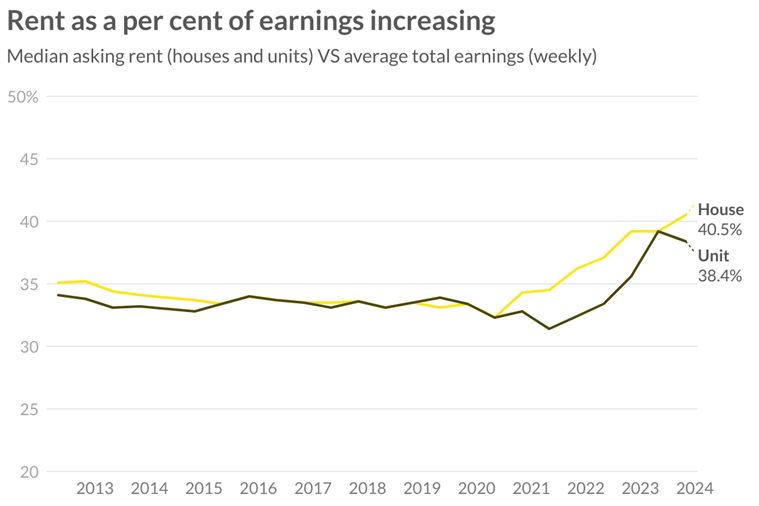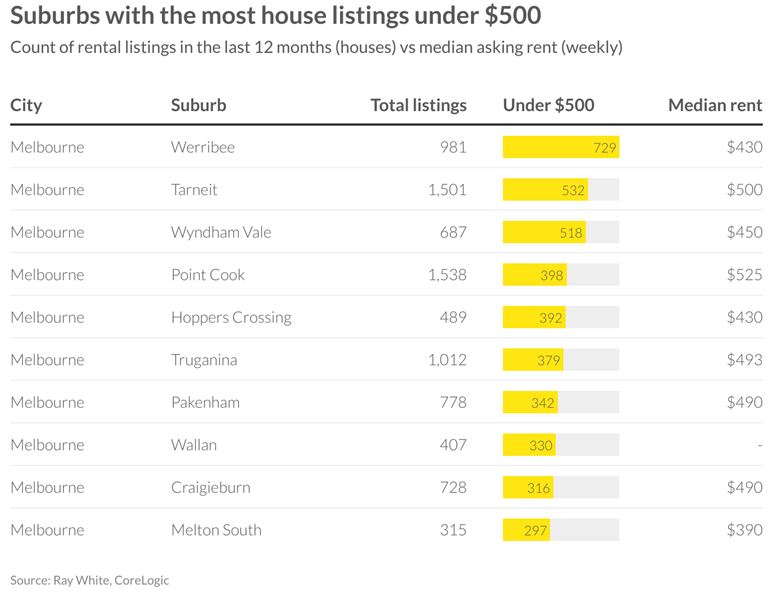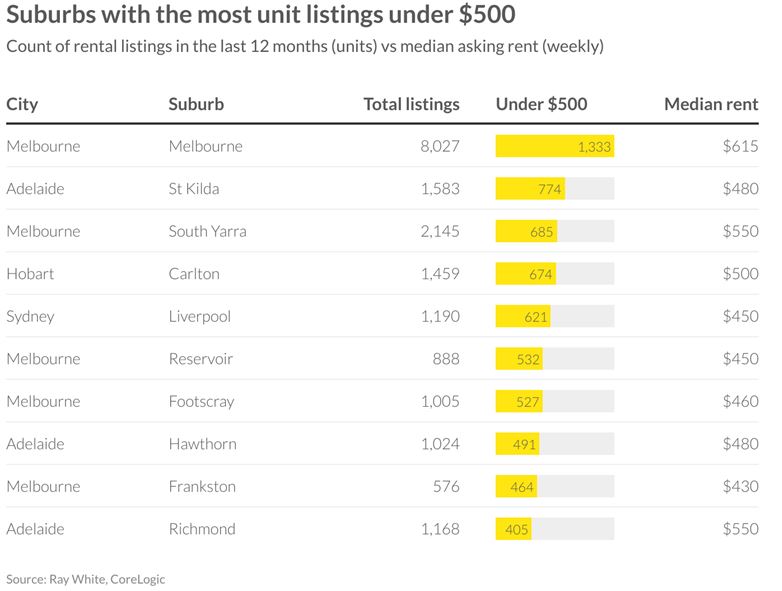Road still bumpy for renters, borrowers on Struggle Street
A slight improvement in vacancy rates has done little to quell the rental crisis, while a disturbing proportion of home owners are also doing it tough and missing mortgage repayments.
Any joy renters might have had that there had been a fractional improvement in vacancy rates around the country have been extinguished by rents still rising.
For home owners struggling to pay the mortgage, the picture is no brighter.
New research has shown that a worrying one in eight borrowers has missed one or more payment deadlines in the past six months.
An additional 32 per cent of borrowers who did pay on time told the Finder survey that they were worried a missed payment was looming as a scary possibility.
Renters have arguably been the hardest hit cohort of Australians as the cost of living and housing crises have become increasingly problematic.
In a glimmer of good news was PropTrack’s Thursday data showing the share of available rentals further increased in May, with the national rental vacancy rate up 0.08 percentage points (ppt) to 1.30 per cent.
This is the highest rental vacancy rate since July 2023, and the first instance of three successive monthly improvements since late-2020.
With overseas migration and student visa applications having peaked, the number of prospective tenants per rental property slightly easing, and more renters entering shared housing options to reduce costs, these factors combined could help to relieve some pressure on the rental market.
According to Rent.com.au statistics released Wednesday (5 June) there was a 7.1 per cent increase in the number of rental properties available nationally in May 2024.
All states and territories recorded increases in rental listing volumes, however, the vacancy rate in Darwin dropped 0.3 per cent to 1.1 per cent in May.
The very modest improvement in vacancy rates the remain chronically tight there was still a 1.7 per cent rise in rents nationally, from $600 to $610 per week. The highest increase in median house rent was recorded in Brisbane (+3.2 per cent; +$20 to $650) while the largest fall was in Canberra (-4.2 per cent; -$30 to $690).
The critical undersupply of current and new rental properties, along continued strong demand and rental price growth, means that it will still be tough going for renters and the rental market will remain extremely challenging for the rest of 2024.
Paul Ryan, Senior Economist, PropTrack, said that while any easing in conditions will be welcomed by renters, available properties remain very scarce with the vacancy rate at around half the levels seen before the pandemic.
“This means competition for rentals will remain strong and rents will continue to increase.
“The easing in conditions over the past three months has been most evident in Perth, Sydney and the ACT, with Perth seeing a substantial improvement after very tough conditions recently.
“While availability remains low across all markets, Adelaide and Brisbane remain the toughest for renters, with rental vacancy rates of 1.03 per cent and 1.11 per cent, respectively.
“We expect renters will face continued difficulty securing rentals and strong rent price growth over the rest of 2024 in these markets,” Mr Ryan said.
Borrowers trying to make ends meet
A worrying number of homeowners are struggling to keep up with their mortgage repayments, according to new research by Finder, Australia’s most visited comparison site.
A Finder survey of 1,071 respondents – 342 of whom have a mortgage – revealed 12 per cent have missed one or more repayments over the past six months.
That’s an estimated 396,000 borrowers who have fallen behind on their mortgage.
The research found 4 per cent of mortgage holders – 132,000 households – say they have missed one repayment.
A further 8 per cent of mortgage holders – 264,000 households – have missed more than one repayment.
The data revealed 3 per cent have had to ask for a repayment holiday or applied for hardship from their lender.
Richard Whitten, home loans expert at Finder, said mortgage defaults were a growing concern.
“Thousands of mortgage holders have weathered rate rises but are now experiencing extreme financial strain as savings and emergency funds run dry.
“Any further hikes would push many to breaking point.”
Shockingly, 1 in 3 borrowers (32 per cent) are worried they will miss a repayment due to mortgage stress. That’s over 1 million Australians at risk of delinquency.
Of those who missed a repayment, a third (33 per cent) said they ran out of money because of other bills, while 31 per cent said interest rates increased and they could no longer afford it.
Whitten said many Aussies are forking out a disproportionate amount of their income paying off their home loan.
“Interest rates rose so rapidly that mortgagors have reached breaking point with some unable to stay financially afloat.”
Variable rate loans remain the near-unanimous choice of borrowers, according to Helen Avis, Director, Specialist Mortgage.
Back in March 2020, at the start of the pandemic, 13.38 per cent of new borrowers were choosing fixed-rate loans and 86.62 per cent were choosing variable. But in March 2024, a staggering low of only 1.40 per cent of new loans were fixed, compared to 98.60 per cent variable, according to the Australian Bureau of Statistics.
“The reason so many borrowers are going variable right now is because of a widespread belief that interest rates are at or near their peak, which means variable borrowers would benefit from any future rate cuts.
“Conversely, in July 2021, when interest rates were at record-low levels, 46 per cent loans were fixed, while only 54 per cent were variable.”
Most affordable rental markets
For those renters wondering where they can get an even break, they might want to head to the southern states.
When it comes to suburbs with listings under $500 per week, nowhere comes close to Melbourne.
According to data released by Ray White on Wednesday (5 June), Melbourne contains all ten of the top 10 list of suburbs with the most house rentals listed under that benchmark price.
The list is slightly more diverse for renters looking for units. Of the top 10 most affordable suburbs, half come from Melbourne, three come from Adelaide, while Hobart and Sydney offer one.
Atom Go Tian, Senior Data Analyst, Ray White Group, said the share of median asking rent versus weekly earnings was 40.5 per cent for houses and 38.4 per cent for units.
According to ABS, average weekly earnings as of November 2023 was $1,431 per week, a 35 per cent increase from 10 years ago. During the same period, rent has outpaced our growth in earnings with the median asking rent for houses growing by 56 per cent to $580 and the median asking rent for units growing by 52 per cent to $550.
Mr Tian said the balance between real income and rent costs has shifted dramatically, with the past two years having crunched renters.
“For the first eight years of the last decade, the share of rent versus earnings stayed relatively flat between 33 and 35 per cent.
“Weekly earnings growth even outpaced rent growth, with the share of rent reaching its lowest point in 2020 for houses at 32 per cent of weekly earnings and in 2021 for units at 31.4 per cent of weekly earnings.
“Since then, however, rent has skyrocketed.”
Meanwhile, on the rental supply front, the Property Council of Australia on Wednesday welcomed the introduction of the Treasury Laws Amendment (Responsible Buy Now Pay Later and Other Measures) Bill 2024 as recognising the role of build-to-rent (BTR) housing in Australia but warned it does not create a level pathway to support 150,000 new BTR homes by 2034.
























